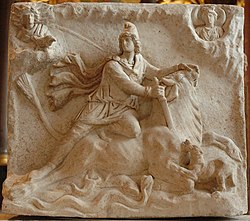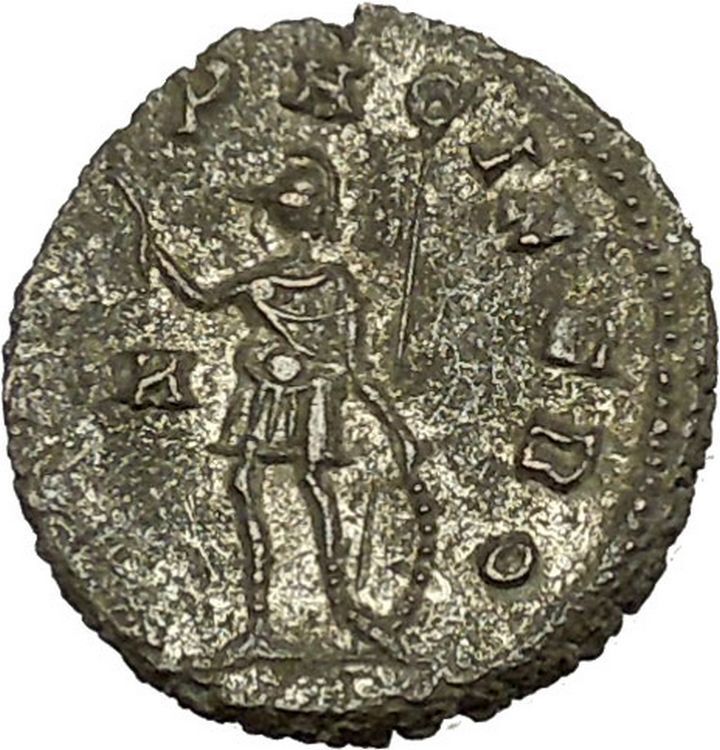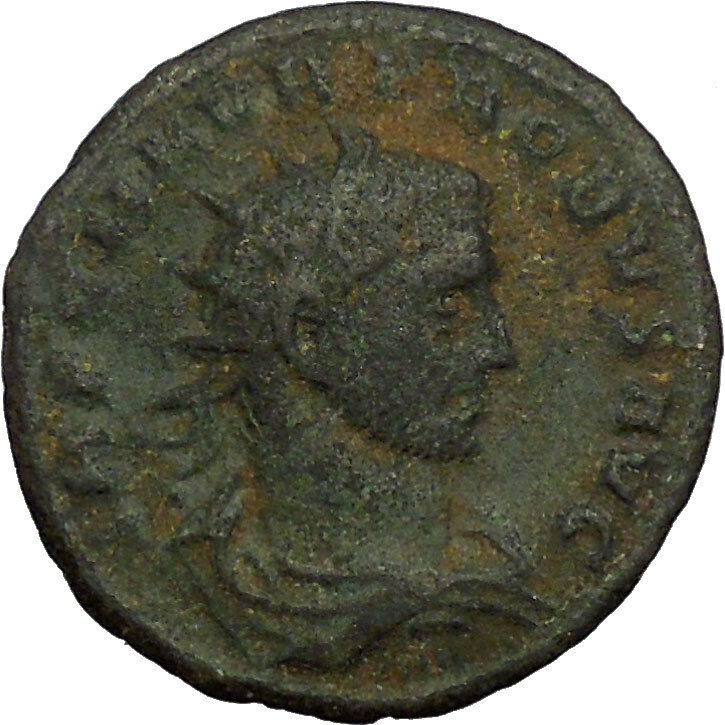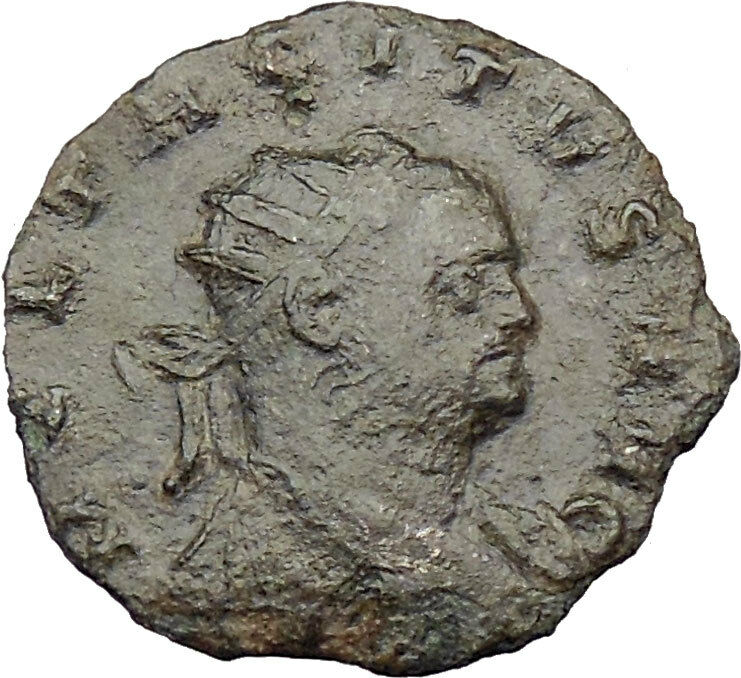|
Faustina II – Roman Empress & Wife
of Emperor Marcus Aurelius – 161-175 A.D. –
Bronze As
28mm (14.34 grams) Rome mint: 161-175
A.D.
Reference: RIC III, 1652; MIR 18,19-7B.
FAVSTINA AVGVSTA, draped bust right
IVNONI REGINAE S-C, Juno standing left holding patera
and sceptre, peacock at foot left.
You
are bidding on the exact item pictured, provided with a
Certificate of Authenticity and Lifetime Guarantee of
Authenticity.
In
ancient Roman religion
and
myth
, Luna is the divine embodiment of
the Moon (Latin luna; cf. English “lunar”). She is often presented as the
female complement of the Sun (Sol) conceived of as a god. Luna is also
sometimes represented as an aspect of the Roman triple goddess (diva
triformis), along with
Proserpina
and
Hecate
. Luna is not always a distinct
goddess, but sometimes rather an
epithet
that specializes a goddess, since both
Diana
and
Juno
are identified as moon goddesses.
In
Roman art
, Luna’s attributes are the crescent
moon and the two-yoke chariot (biga).
In the
Carmen Saeculare
, performed in 17 BC,
Horace
invokes her as the “two-horned queen of
the stars” (siderum regina bicornis), bidding her to listen to the girls
singing as Apollo
listens to the boys.
Varro
categorized Luna and Sol among the
visible gods, as distinguished from invisible gods such as
Neptune
, and deified mortals such as
Hercules
. She was one of the deities
Macrobius
proposed as the secret
tutelary
of Rome. In
Imperial cult
, Sol and Luna can represent the
extent of Roman rule over the world, with the aim of guaranteeing
peace
.
Luna’s
Greek counterpart
was
Selene
. In Roman art and
literature
, myths of Selene are adapted under
the name of Luna. The myth of
Endymion
, for instance, was a popular subject
for Roman wall painting.
Temples and cult
Luna had a temple on the
Aventine Hill
, just below a temple of Diana. As
Noctiluna (“Night-Shiner”) she had a temple on the
Palatine Hill
.
Titus Tatius
was supposed to have imported the
cult of Luna to Rome from the
Sabines
.
Varro
lists Luna among twelve deities who are
vital to
agriculture
, as does
Vergil
in a different list of twelve, in which
he refers to Luna and Sol as clarissima mundi lumina, the world’s
clearest sources of light.
Varro also lists Luna among twenty principal gods of Rome (di
selecti). In this list, Luna is distinguished from both Diana and Juno, who
also appear on it.
Juno as moon goddess
The
Kalends
of every month, when according to the
lunar calendar
the new moon occurred, was
sacred to Juno, as all
Ides
were to
Jupiter
.
On the
Nones
, she was honored as Juno Covella, Juno of
the crescent moon. Both Juno and Diana were invoked as
childbirth goddesses
with the epithet
Lucina
.
Chariot of the moon
In this
relief
depicting a Mithraic
tauroctony
, Luna drives a
biga drawn by oxen (right), while the Sun drives a
horse-drawn quadriga (left)
Luna (top right corner) paired with the Sun (top left) in
another depiction of the tauroctony
Luna is often depicted driving a two-yoke chariot (biga),
drawn by horses or oxen. In Roman art, the charioteer Luna is regularly paired
with the Sun driving a four-horse chariot (quadriga).
Isidore of Seville
explains that the
quadriga
represents the sun’s course
through the four seasons, while the biga represents the moon, “because it
travels on a twin course with the sun, or because it is visible both by day and
by night—for they yoke together one black horse and one white.”
Luna in her biga was an element of
Mithraic
iconography, usually in the context of
the tauroctony
. In the
mithraeum
of S. Maria Capua Vetere, a wall
painting that uniquely focuses on Luna alone shows one of the horses of the team
as light in color, with the other a dark brown.
A biga of oxen was also driven by
Hecate
, the
chthonic
aspect of the triple goddess in
complement with the “horned” or crescent-crowned
Diana
and Luna. The three-form Hecate (trimorphos)
was identified by
Servius
with Luna, Diana, and
Proserpina
. According to the
Archaic Greek
poet
Hesiod
, Hecate originally had power over the
heavens, land, and sea, not as in the later tradition heaven, earth, and
underworld.
Juno was an
ancient Roman goddess
, the protector and special counselor of the state. She
is a daughter of
Saturn
and sister (but also the wife) of the chief god
Jupiter
and the mother of
Mars
, Minerva
and
Vulcan
. Her Greek equivalent is
Hera.
As the
patron goddess
of Rome
and the
Roman empire
she was called Regina (“queen”) and, together with Jupiter and
Minerva
, was
worshipped as a triad on the Capitol (Juno Capitolina) in Rome.
As the great Juno
Moneta
(which
the ancients interpreted as “the one who warns”; this traditional etymology is
badly formed, but has not been replaced) she guarded over the finances of the
empire and had a temple on the
Arx
(one of two Capitoline hills), which was the
Mint
.
She was also worshipped in many other cities, where temples were built in her
honor.
Every year, on the first of March, women held a festival in honor of Juno
called the Matronalia
. On this day, lambs and other cattle were sacrificed in her
honor. Another festival called the
Nonae Caprotinae
(“The Nones of the Wild Fig”) was held on July 7. Juno is
the patroness of marriage, and many people believe that the most favorable time
to marry is June, the month named after the goddess.
Lucina
was an epithet for Juno as “she who brings children into light.”
Juno’s own warlike aspect among the Romans is apparent in her attire. She
often appeared armed and wearing a goatskin cloak, which was the garment
favoured by Roman soldiers on campaign. This warlike aspect was assimilated from
the Greek goddess Athena
, whose goatskin was called the ‘aegis’.
Annia
Galeria Faustina Minor (Minor Latin for
the younger), Faustina Minor or Faustina
the Younger

(February
16 between 125 and 130-175) was a daughter of
Roman Emperor
Antoninus Pius
and Roman Empress
Faustina the Elder
. She was a Roman Empress and wife
to her maternal cousin Roman Emperor
Marcus Aurelius
. Though Roman sources give a
generally negative view of her character, she was held
in high esteem by soldiers and her own husband and was
given divine honours after her death.
//
Biography
Faustina, named after her mother, was
her parents’ fourth and youngest child and their second
daughter; she was also their only child to survive to
adulthood. She was born and raised in
Rome
.
Her great uncle, the Emperor
Hadrian
, had arranged with her father for Faustina
to marry
Lucius Verus
. On February 25, 138, she and Verus
were betrothed.
Verus’ father
was Hadrian’s first adopted son and
his intended heir. However when Verus’ father died,
Hadrian chose Faustina’s father to be his second adopted
son, and eventually, he became Hadrian’s successor.
Faustina’s father ended the engagement between his
daughter and Verus and arranged for Faustina’s betrothal
to her maternal cousin,
Marcus Aurelius
; Aurelius was also adopted by her
father. On May 13, 145, Faustina and Marcus Aurelius
were married. When her father died on March 7, 161, her
husband and Lucius Verus succeeded to her father’s
throne and became co-rulers. Faustina was given the
title of
Augusta
and became Empress.
Unfortunately, not much has survived
from the Roman sources regarding Faustina’s life, but
what is available does not give a good report.
Cassius Dio
and the
Augustan History
accuse Faustina of ordering
deaths by poison and execution; she has also been
accused of instigating the revolt of
Avidius Cassius
against her husband. The Augustan
History mentions adultery with sailors, gladiators,
and men of rank. However, Faustina and Aurelius seem to
have been very close and mutually devoted. Her husband
trusted her and defended her vigorously against
detractors.
Faustina accompanied her husband on
various military campaigns and enjoyed the love and
reverence of Roman soldiers. Aurelius gave her the title
of Mater Castrorum or Mother of the Camp.
Between 170-174, she was in the north, and in 175, she
accompanied Aurelius to the east. However, these
experiences took their toll on Faustina, who died in the
winter of 175, after an accident, at the military camp
in Halala (a city in the
Taurus Mountains
in
Cappadocia
).
Aurelius grieved much for his wife
and buried her in the Mausoleum of Hadrian in Rome. She
was deified: her statue was placed in the Temple of
Venus in Rome and a temple was dedicated to her in her
honor. Halala’s name was changed to Faustinopolis
and Aurelius opened charity schools for orphan girls
called Puellae Faustinianae or ‘Girls of
Faustina’.
The Baths of Faustina in
Miletus
are named after her.
In their thirty years of marriage,
Faustina bore Marcus Aurelius thirteen children:
-
Annia Aurelia Galeria Faustina
(147-after 165)
-
Gemellus Lucillae (died around
150), twin brother of Lucilla
-
Annia Aurelia Galeria
Lucilla
(148/50-182), twin sister of Gemellus,
married her father’s co-ruler
Lucius Verus
-
Titus Aelius Antoninus (born
after 150, died before 7 March 161)
-
Titus Aelius Aurelius (born after
150, died before 7 March 161)
-
Hadrianus (152-157)
-
Domitia Faustina (born after 150,
died before 7 March 161)
-
Fadilla
(159-after 211)
-
Annia Cornificia Faustina Minor
(160-after 211)
-
Titus Aurelius Fulvus Antoninus
(161-165), twin brother of Commodus
-
Commodus
(161-192), twin brother of Titus
Aurelius Fulvus Antoninus, later emperor
-
Marcus Annius Verus Caesar
(162-169)
- Vibia Aurelia Sabina (170-died before 217)
|













